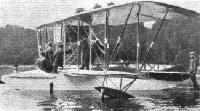O.Thetford, P.Gray German Aircraft of the First World War (Putnam)
Rumpler 4E
This flying-boat was built in 1914. Engine, 120 h.p. Austro-Daimler. Span, 15.7 m. (51 ft. 4 3/4 in.). Length, 8.94 m. (29 ft. 0 in.). Height, 3.4 m. (11 ft. 0 in.).
Показать полностью
J.Herris Rumpler Aircraft of WWI (A Centennial Perspective on Great War Airplanes 11)
Rumpler 4E Flying Boat
The Rumpler 4E was a flying boat built in 1914 powered by a 150 hp Benz Bz.III engine. Records indicate that only one aircraft, Marine Number 47, was built.
Показать полностью
Журнал Flight
Flight, October 16, 1914.
AIRCRAFT "MADE IN GERMANY"
WHICH MAY BE EMPLOYED AGAINST THE ALLIES.
17. The Rumpler Flying Boat
does not differ materially in its general arrangement from the various well-known American flying boats. The hull or boat has a single step placed approximately under the centre of gravity. The bottom of the boat behind the step has a concave curvature, gradually flattening out towards the stern. In front the boat is flat bottomed. Constructionally it is built up over a framework of ash covered with three-ply and six-ply wood on the sides and bottom respectively. The two seats, which are situated just in front of the leading edge of the lower main plane, are placed side by side, the pilot sitting on the right. Control is by means of rotatable hand-wheel, mounted on a vertical pivotted column, and a footpath for the rudder. The engine, a 150 h.p. 6-cylinder Benz, is mounted on a structure of steel tubes approximately half way between the two planes. It drives directly a propeller placed behind the main planes, of which the upper one has the trailing edge cut away in the centre to provide the necessary clearance. In front of the engine, and mounted on the engine bearers, is the radiator, whilst the petrol and oil tanks, which have a capacity sufficient for a flight of four and a half hours' duration, are placed down in the hull, whence the fuel is forced up to a small service tank near the engine by a pressure pump.
The upper main plane, which has a considerable overhang, the weight of which is taken by struts sloping outwards from the bases of the outer inter-plane struts, is built up in five sections in order to facilitate transport. The outer sections or extensions are hinged, and may be folded down, thus reducing the overall span of the machine to that of the lower plane. The inter-plane struts are of streamline section, and built up of two pieces of spruce hollowed out and glued and bound together.
The tail planes are built up of frameworks of steel tubing covered with fabric. They consist of a fixed horizontal tail plane, to which is hinged the divided elevator, and of a triangular vertical fin, to the trailing edge of which is hinged the balanced rudder. Two small wing-tip floats, supported on steel tube structures, provide the necessary lateral stability on the water.
Показать полностью







